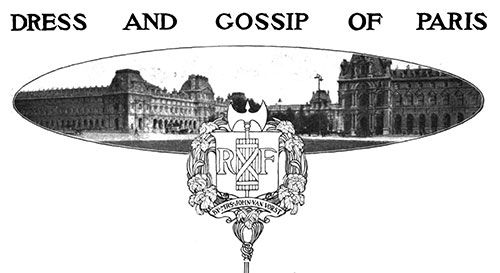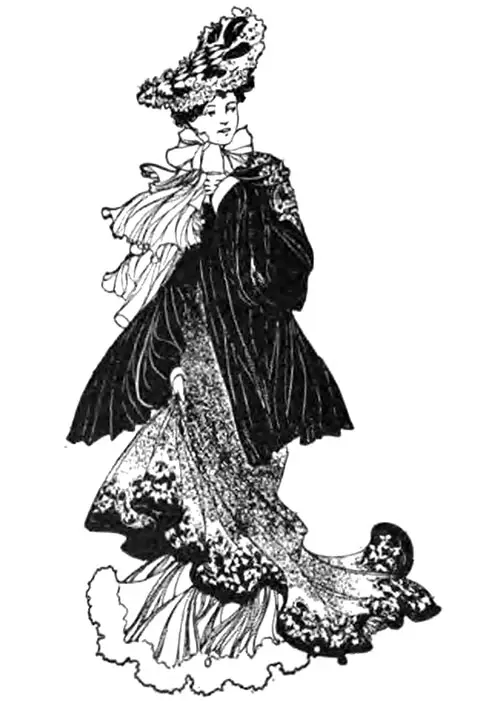Paris Dress Fashions and Gossip – August 1903

The danger, one might say, of the present fashions is too much similarity in general outline, owing to the extreme fullness of sleeves and skirts, the looseness of jackets and cloaks, and the large size of hats.
In choosing the three or four dresses necessary for the Summer season one should be careful that they vary in their genre, or cut, and style.
The house dress and the informal evening dress must be of the most flimsy material, chiffon, toile de soie or crepe de Chine, the last, perhaps, being most fashionable.
These costumes are trimmed with an abundance of lace, with deep collars, inserted bands, fringes, puffings—all that is light, diaphanous, and truly feminine.
The outdoor dress, on the other hand, must be correct, and its beauty must lie in the bold and harmonious combination of colors and in the perfection of its cut and fit.
A charming afternoon Summer gown for garden parties and teas is made of white muslin with a wide flounce of Liberty silk encrusted with bands of white lace.
The flounce is applied to the skirt in points, and over it there is a trimming of yellow guipure in scallops which intersect the insertion of the flounce.
The blouse, which is extremely simple in its construction, is made with a high belt of Liberty silk and a double fichu of white muslin covered with yellow guipure for traveling, or driving trips, a correct dress is made of beige and white etamine with no other trimming than the black passementerie drops and frogs on the skirt and coat.
The latter is cut with long coat-tails and fastened in the front over a man's cravat and a white linen collar. The sleeves have deep cuffs of écru linen.

An attractive dress of the more Parisian style is made in mauve toile de soie. The skirt has on each of its box pleats a square of fancy silk, a medallion, outlined with a tiny ruche of the toile.
The blouse is made with a full bolero, a front of white embroidered batiste, and it is trimmed, like the skirt and the sleeves, with the fancy silk. The hat worn with this costume is a three-cornered pale green straw edged with a band of black velvet. At the left, a group of ostrich leathers falls just over the brim.
Lace and batiste collars are worn in profusion. They have the uniform round shape known as the Van Dyke.
Parasols, which have been quite simple for a long time, are this year made in two and three flounces like a lamp-shade, or with puffings of lace, ruches of taffetas or garlands of flowers.
In hats, the general movement is more narrow and very much higher. The trimming is placed in the front as well as at the side. The full short cloaks, having become fuller and shorter than ever, are now often made without sleeves, and in this case are nothing more or less than the pelerines or shoulder capes which were worn several years ago.
For tennis and golf, extreme simplicity is the note: a skirt of serge or linen duck, a shirt-waist of toile de soie or batiste, a cravat of embroidered muslin, and a stiff hat with one quill caught in place by a rosette of ribbon.
A charming new model for convenient use at the seashore where one must be elaborately dressed is in mousseline de soie of the latest tint—jade. The skirt gathered around the hips, is terminated at the hem by three flounces, each mounted with a heading or ruche of taffetas.
The blouse is pulled into a high belt and trimmed with alternate ruches of taffetas and tiny flounces of mousseline de soie, which continue down the sleeve to the elbow. The chic of the dress is the double cocarde of black chiffon, which closes the bodice in front.
With the incrustations and open-work trimmings used this season, it is very practical to have a lining of either white or pale-colored silk, which serves for a number of dresses, provided they are in thin materials, such as dotted muslin.
The new lace, craponne, is made of the coarsest linen thread. It is to be had in white and écru and is used in widths varying from eight to eighteen inches. Upon white duck skirts and boleros it is extensively employed, and for these purposes, nothing is more fashionable.
Shirt-waists of toile de soie and tussore are more worn than batiste, and the embroidered shirts are less popular than last year. Tussore in the natural pongee color is used for entire dresses, and the coarser it is the more style it has.
This sudden innovation of the Indian material, which cannot be procured in any color but ecru, tends to make the fashions revert from the feminine chemisettes in embroidered and incrusted batistes to the rather more masculine blouses with simple tucks front and back and small sleeves, also tucked.
A pretty, white piqué with small black polka dots is trimmed by bias bands of taffetas which follow the hem of the skirt in circles and outline the guimpe of white guipure.
Some dresses are made without collars; others are made with very high standing collars. When sleeves are worn only to the elbow, they are tight-fitting and have no fullness or “balloon.”
Van Vorst, Mrs. John, “Dress and Gossip of Paris” in The Delineator: An Illustrated Magazine of Literature and Fashion, Paris-London-New York-Toronto: The Butterick Publishing Co., Ltd., Vol. LXII, No. 2, August 1903, p. 199.
Editor's Note: Some terminology used in the description of women's clothing during the 1800s and early 1900s has been changed to reflect more modern terms. For example, a women's "Toilette" -- a form of costume or outfit has an entirely different common meaning in the 21st century. Typical terms applied to "toilette" include outfit, ensemble, or costume, depending on context.

